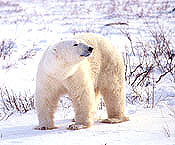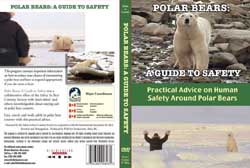Appearance and Size
 The Polar Bear (Ursus maritimus) is the largest land carnivore in North America. Adult males measure from 240 to 260 cm in total length and usually weigh from 400 to 600 kg, although they can weigh up to 800. They do not reach their maximum size until they are eight to 10 years old. Adult females are about half the size of males and reach adult size by their fifth or sixth year, when most weigh from 150 to 250 kg. Pregnant females can weigh up to 400 or 500 kg just before entering their maternity dens in the fall.
The Polar Bear (Ursus maritimus) is the largest land carnivore in North America. Adult males measure from 240 to 260 cm in total length and usually weigh from 400 to 600 kg, although they can weigh up to 800. They do not reach their maximum size until they are eight to 10 years old. Adult females are about half the size of males and reach adult size by their fifth or sixth year, when most weigh from 150 to 250 kg. Pregnant females can weigh up to 400 or 500 kg just before entering their maternity dens in the fall.
The bodies of polar bears are longer than the bodies of grizzly bears; their necks and skulls are also longer, but their ears are smaller. Instead of having the characteristic “dished” or concave facial profile of grizzly bears, polar bears possess a more prominent or “Roman” nose. Their canine teeth are large, and the grinding surfaces of their cheek teeth are jagged, which is an adaptation to a carnivorous diet. Polar bear claws are brownish in colour, short, fairly straight, sharply pointed, and non-retractable.
Polar bears are adapted to their arctic surroundings. They possess thick white winter coats, with glossy guard hairs and dense under fur, and the thick layer of fat beneath their skin protect them against the cold. Polar bear hair sheds water easily and is translucent which reflects the heat from the sun down to the base of the hair, where it is absorbed by the black skin.
Distribution and Life History
Polar bears are most common along the coastal areas of the Arctic and the between-island channels of the various archipelagos in the Arctic. Small numbers of bears enter the permanent pack ice that lies over the central polar basin, and some have been recorded as far north as 88°N latitude. (The North Pole is 90°N latitude.) A few polar bears regularly appear as far south as Newfoundland and Labrador, and they have occasionally been noted in the Gulf of St. Lawrence in years when heavy pack ice drifts further to the south than normal.
Polar bears prefer areas of annual ice, which they use for a hunting platform and protective cover. This habitat preference is closely linked to the presence of their preferred food, ringed seals. In areas such as eastern Baffin Island and Hudson Bay, where most or all of the pack ice melts by mid to late summer, the whole bear population is forced to come ashore for two to four months in summer and early fall to wait for the ice to freeze again.
One of the three largest maternity denning areas for polar bears worldwide is in Canada, near Churchill, Manitoba, on the western coast of Hudson Bay. The others are on Wrangell Island, in Russia, and in Kong Karls Land in Svalbard, Norway, in the Arctic Ocean.
Polar bears are considered to be marine mammals because they depend upon seals and the marine environment for their existence. They feed mostly on ringed seals, but they also catch bearded seals, harp seals, hooded seals, and harbour seals. Occasionally, they may also kill walruses, belugas or white whales, and narwhals. When the bears come ashore in areas where the pack ice melts during the summer, they can no longer hunt seals. They live mainly on their fat stores and conserve energy by remaining inactive over 80 percent of the time. They will scavenge on carcasses if they find them, and occasionally eat grasses and berries. Very few cases of bears killing and eating caribou and muskoxen are known.
Polar bears have the ability to slow down their metabolism to conserve energy at any time of year. This occurs after seven to 10 days of not being able to feed and lasts until food becomes available again. In comparison, black or grizzly bears can slow down their metabolism only in response to not feeding in the late fall, just before they enter their dens for the winter. If food is removed from black or brown bears in spring or summer when they are not in their winter dens, they will starve to death.
When hunting, polar bears rely mainly on their keen sense of smell. They can detect seal breathing holes covered by layers of ice and snow 90 cm or more thick and up to a kilometer away. Their eyesight and hearing are similar to those of a human.
Polar bears are excellent swimmers. They use their large front paws as powerful oars when they swim, while their rear paws trail behind and act like rudders. Underwater, they keep their eyes open can remain submerged for over a minute.
Although polar bears of both sexes and all ages may occupy temporary dens or shelters during periods of cold or stormy weather, only pregnant females remain in dens throughout the winter.
Males and females become sexually mature when they are four or five years old. Although the females may mate then and produce cubs, most males don’t breed until they are eight to 10 years old. Because cubs usually stay with their mothers for two and a half years, the most often a female is normally capable of having a litter is every three years. This is a very slow breeding rate, which explains why depleted populations take so long to recover.
Mating occurs in April and May, when polar bears are out on the pack ice hunting seals. However, the fertilized egg does not implant in the uterus and begin to grow until mid-September to mid-October. Through most of the Arctic, maternity denning begins about mid-October. The pregnant females search for deep snowdrifts near the coast. Often they excavate their dens on the south-facing slopes of hills or valleys, where prevailing northerly winds pile up deep snowdrifts.
The young are born after about two months of gestation, from late November to early January, depending on latitude. The most common litter size is twins, followed by singletons. Triplets are born periodically, especially when feeding conditions have been good and the females are able to put on a lot of fat before denning.
At birth, the cubs are only about 25 cm long and weigh less than one kilogram. Their eyes are closed at birth, and they are covered with hair so fine that in some early descriptions the cubs were reported to be hairless.
Male polar bears commonly live to about 25 years of age. Females often live into their late twenties.
Polar Bear Country
When working or traveling in polar bear country some special considerations need to be taken. Polar bears inhabit an environment that often has minimal cover and often an encounter can be prevented when the bear is spotted at a distance. Be alert and aware of your surroundings.
- Scan all around with binoculars at regular intervals.
- Watch for signs such as tracks, droppings, diggings, wildlife carcasses and polar bear dens.
- Travel in daylight and avoid areas of restricted visibility.
- Be especially careful in areas along the coast, where a polar bear may be hidden behind boulders, pressure ridges (pushed up sea ice), driftwood or vegetation.
- Travel in groups and stay together to increase your safety. The larger the group the greater the chances of deterring a bear.
Avoid bear feeding areas. A polar bear’s primary food source is the ringed seal and these species are often found in the same places
- In fall, winter and early spring most polar bears are on the sea ice hunting seals by the flow edge, open water leads and along pressure ridges. Bears and seals can also be found in places where the ice is thin or cracked, such as tide cracks in land-fast ice or at toes of glaciers. Seals can more easily maintain breathing holes in these areas.
- In early spring, females with cubs tend to hunt along pressure ridges and cracks in land fast ice (particularly in bays) where seal birthing dens are found.
- During the ice-free summer season, when polar bears are forced ashore, they generally hunt and scavenge along coastlines, beaches and rocky islands near the coast
Avoid polar bear den sites. Unlike black or grizzly bears, there is no time when all polar bears are inactive in dens.
- Maternity dens are excavated by pregnant females in snow drifts on wind protected slopes of coastal hills and valleys. In the Baffin Region, dens can be found at high elevations on snowfields and glaciers. Maternity dens are occupied from fall to early spring. The dens are inconspicuous, however, bear tracks leading to and from the site in early autumn or late spring or ventilation holes can indicate their presence.
- Temporary dens are excavated in snow drifts or pressure ridges by polar bears (males, females and females with cubs) that are active over the winter. The dens can be used as resting places or as temporary shelter from bad weather. They can be used from a few days to several months.
- Summer retreat dens are excavated during the open water season in the remaining snow banks or into the permafrost. These can also be at higher elevations on snowfields and glaciers or the valleys leading up to them. Male and female bears of all age groups use them to keep cool and avoid harassment by insects.
Avoid camping under the stars at all times and avoid camping in a tent whenever possible. If you have no other choice but to sleep outside of a hard-sided secure building, avoid tenting on beaches, islands, along coastlines and on travel routes. Polar bears often travel along coastlines using points of land and rocky islets near the coast to navigate.
- Before making camp, look for signs of polar bear activity such as tracks.
- In the summer, blowing sea ice may transport polar bears into coastal areas. Avoid areas where the pack ice is blowing in to shore. Valleys and passes are often used to cross peninsulas and to move from one valley to another. Polar bears travel and hunt along the edges of ice floes.
- Camp inland on a butte or bluff with a good view of surrounding terrain.
- Avoid areas where bears might hide, such as blind corners, snow banks, pressure ridges and other visual impediments.
- Set up tents in a line rather than a circle and maintain at least 5 metres between them. If a bear comes into camp, it will not feel surrounded and will have an avenue of escape without feeling threatened.
- Do not sleep in the open without a tent. You may look like a seal and polar bears are very curious.
- Eliminate or reduce food and cooking odors by utilizing bear-proof storage containers.
Final Word:
Prevention is key. Learn how to manage encounters safely using non-lethal deterrents.
Resources:
 Polar Bears: A Guide to Safety is a 27-minute video that contains important information on how people can reduce their chance of encountering a polar bear and how to best respond if they do meet a bear. Polar Bears: a Guide to Safety was a collaborative effort of the Safety in Bear Country Society with many people knowledgeable about staying safe in polar bear country, including Inuit elders and polar bear hunters, other northern residents, research scientists, wildlife managers, and bear viewing operators.
Polar Bears: A Guide to Safety is a 27-minute video that contains important information on how people can reduce their chance of encountering a polar bear and how to best respond if they do meet a bear. Polar Bears: a Guide to Safety was a collaborative effort of the Safety in Bear Country Society with many people knowledgeable about staying safe in polar bear country, including Inuit elders and polar bear hunters, other northern residents, research scientists, wildlife managers, and bear viewing operators.
Click here to read the script in English.
Polar Bears: a Guide to Safety is available in English, French and Inuktitut. Video or DVD formats can be purchased from Kodiak Wildlife Products Inc. They can be purchased for home use or with Public Presentation Rights (PPR), which means they are licenced to allow showings to non-paying audiences.
Learn more here.
